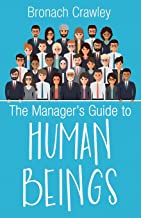The Manager’s Guide to Human Beings
Understanding Our Human Nature At Work


Trained as both a clinical and occupational psychologist, Bronach Crawley has worked in the commercial world for over thirty-five years, as HR and career development consultant, university lecturer and more recently as director of the Domino Partnership. She is a specialist in assessment, psychological profiling, facilitation and coaching at senior levels with teams and individuals. Throughout her interest has been on uncovering the real reasons why humans do what they do.
From the beginnings of the Agrarian Revolution in the late 18th-century, and accelerating through the Industrial Revolution, the focus of organised labour has been on increasing efficiency. In a world where any paid work was an improvement on scratching a subsistence living in growing urban centres, the unitisation of work roles was acceptable, however in the late 20th and particularly now in the early 21st century, the treatment of humans as cogs in ever-more efficient machines has begun to lose its effectiveness. The needs of modern businesses are more for innovation, adaptation and collaboration – things that humans are more innately capable of than machines (not withstanding the advance of AI and machine learning). Bronach Crawley tackles this emerging crisis of work with a look at how organisations can remedy culture and advance their productivity in the process.
"We are not as modern and enlightened as we may wish to believe" asserts Crawley, and this is the underlying theme of the book. While we intellectually may operate at a rarefied level, emotionally we are still not that distant from our hunter-gatherer ancestors, "our emotions are with us at every moment of every day, exerting a powerful influence on the path we follow, even if we are unaware of it at times." To address this Crawley describes the levels humans operate at, in a Maslow-like hierarchy. At the base is our 'core human needs', with these satisfied we are driven by our 'values and beliefs' and shape these with our 'styles and preferences' to produce our behaviours. The initial simplicity of this model is made more complex by the fact that the different levels are permeable and can be influenced from the top-down as well as the bottom-up. Neuroscience has shone a spotlight on how these interactions work – but Crawley believes we don't need neuro-analysis to understand this, we humans are pretty good at doing it anyway – we just need to (re-)awaken ourselves to the signals.
“Learning to manage people is as much about understanding ourselves as it is about understanding those who work for us, with and around us”. Crawley’s advice is to ‘not think about them, but about us’. The book takes us through an exploration of the four levels and then a deeper dive into the core needs of feeling safe (and countering fear), self-worth (the fact each and everyone of us matters), belonging (the importance of community) and the need to change, cope with change and keep changing.
This very readable and down-to-earth book surfaces many concepts and thoughts that readers may well have a deep intuition about already, but its clarity and the evidence behind it, powerfully reinforces and articulates that intuitive recognition and hopefully will spur readers to consider these issues in their own management practice.
Title: The Manager's Guide to Human Beings: Understanding our human nature at work
Author/s Name/s: Bronach Crawley
Publisher: Bouncing Books
ISBN: 978-0-993-02123-7
Publishing Date: February, 2019
Number of Pages: 272
Author Knowledge Rating: 1-5 (based on their years of experience, academic expertise in subject areas, and exposure to cross-functional thinking in the area)





























































Readability: 1-5 score(1=dense and v academic; 5=frantic; page turner)































































































Appropriate Length: (1=could have been written in 25% of the length;5=could have been longer)















































































Core Idea Value: (1=nonsense (or entirely esoteric); 5=game-changer)






























































































